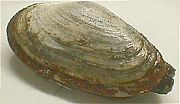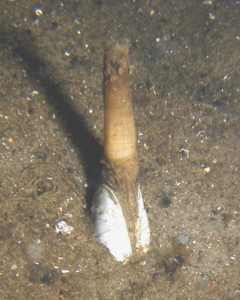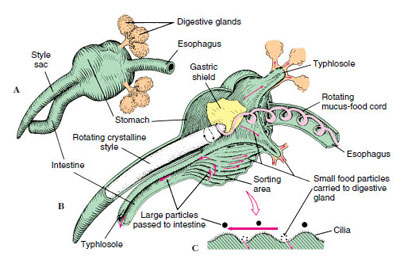
There are many species of clams living in Barnegat Bay.
Soft Shell Clam
Soft Shell Clam Mya arenaria
 The soft shell clam has thin, oval, elongated shells.
The soft shell clam has thin, oval, elongated shells.
The shells are chalky white with a thin, parchment-like covering that varies in color from brownish to yellowish to gray.
The left valve has a spoon-like depression at the hinge.
When closed, the shells gape at both ends and a foot and two siphons protrude from either end.
Both siphons are enclosed in a leathery membrane.
Soft shell clams grow to about 3 to 4 inches.
Fun Fact – Unlike most other clams, the soft shell clam cannot completely retract its siphon into its shell.
 Soft shell clams live buried in the sediment on tidal flats.
Soft shell clams live buried in the sediment on tidal flats.
While they are common in muddy areas, their name “arenaria” means sandy and they prefer a combination of sandy and muddy areas.
This clam is found living approximately 3–8 inches under the surface of the mud.
It extends its paired siphons up to the surface, which draw in seawater, filter it for food, and expel it.
Water may be visibly ejected from the siphon tips when pressure is applied to the surrounding mud.
Fun Fact – Soft Shell Clam are also known as “steamers”, “piss clams”, “softshells”, “longnecks” and in New England “Ipswich clams” or “Essex clams” (towns in Massachusetts)
Fun Fact – The term “piss clams” comes from the fact that because the siphon often sticks up through the sand and the clams unwittingly revealing their location by spurting water.

